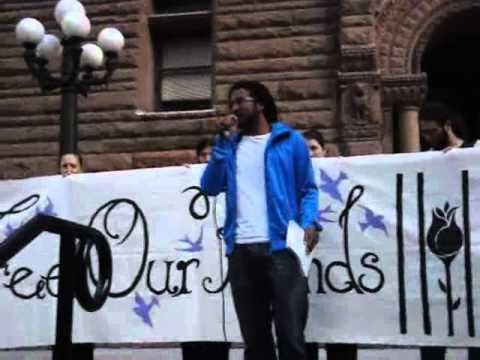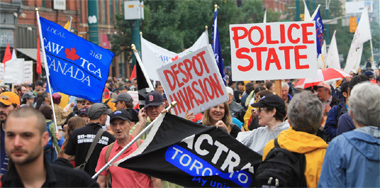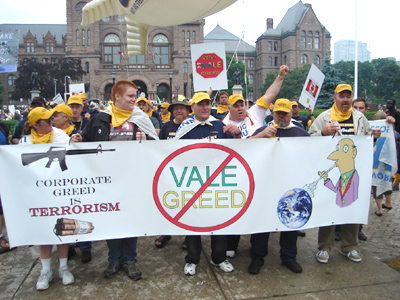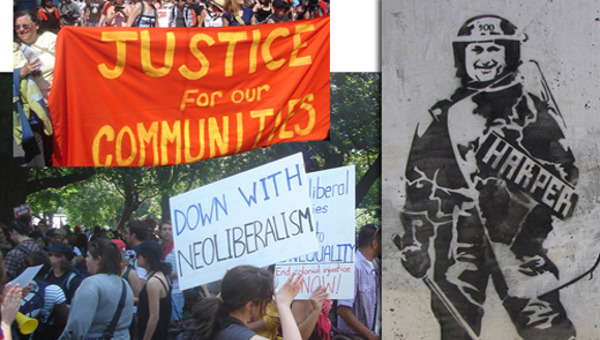Weighing Up the G20: From Toronto to Korea to the Left
The G20 meetings in Seoul, Korea are scheduled for November 11-12. It is clear that like the Toronto meetings of June that they will be pre-occupied with the world economy, the ongoing financial crisis, and the push for austerity against concerns of a second sharp fall in economic growth. As in Toronto, security will be a central concern with the meetings to be held on three artificial islands being built on the Han River between the Banpo and Dongjak bridges, with access restricted to a few security bridges. The Korean Armed Forces and the Metropolitan Seoul Police Agency will provide security.
South Korean workers and popular movements have a long history of mass protest and organization, and the struggles and strikes over neoliberalism in the last few years have been particularly charged, with hundreds of thousands engaged in protests. The Korean Confederation of Trade Unions has already announced a march and rally for November. They have promised “to stage a massive anti-neoliberalism struggle that will gain the attention of people and workers around the globe.” There is also parallel ‘People’s G20 Response Preparation Committee’ organizing a Peoples’ Summit, as part of a week of collective action focused on responses to the economic crisis. How events will unfold in the fall is, of course, anyone’s guess. But it is clear that the leaders plotting to defend the financial system and the capitalist classes in the barricaded islands in the Han River will not go uncontested.
It is because of the urgency of building organizational responses to neoliberalism, and particularly the drive to austerity that is having the poor and workers pay for the financial crisis while the scoundrels in the banks and hedge funds find themselves again thick with bonus pay, that the debates over the G20 meetings and protests in Toronto in June continue to draw attention. The events highlighted central dilemmas confronting the left in Canada – notably, the impasse of the union movement, the decade and longer spiral into disorganization of the social movements, and the weakness of the radical left – alongside the massive strengthening of the ‘security state’ and policing forces at all levels. But the mass popular rejection of the bank bailouts, the austerity cuts, ecological degradation, and colonization were also prominently on display. The Bullet has carried numerous pieces already on political issues leading up to the G20 meetings, and subsequent debates about the protests and policing. Here two further contributions to socialist discussions are added to the mix.
— Socialist Project
Where Do We Go from Here?
The G20 Summit, Black Bloc, and the Canadian Left
Ali Mustafa
Background
Public outcry continues to grow across Canada over the widespread abuse of civil liberties during the recent G20 Summit in Toronto. Over 1,000 people were rounded-up and arrested between June 26th-27th, resulting in the largest mass arrest in Canadian history. While the majority of those arrested have since been released, at least 16 people remain under strict bail conditions and face a variety of serious criminal charges. Countless others who managed to avoid arrest were indiscriminately searched, detained for hours, and even violently attacked by police.
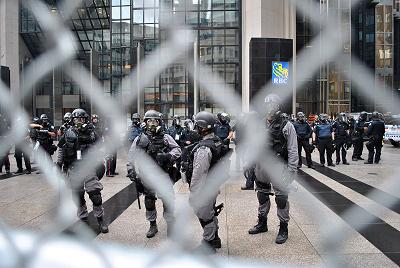
Yet what is particularly troubling about the G20 Summit is not so much the unprecedented $1-billion security cost or sweeping police power put on display but the new ‘age of austerity’ that promises to follow – one that will look to fully exploit the new precedent of state violence now in place. Just like any ‘moment’ of crisis, whether the long-term fallout will translate into the normalization of a new austerity regime or the mobilization of a new Canadian Left in response remains to be seen. The immediate question before us now is where do we go from here?
A New Canadian Left?
Much of the ongoing controversy about the G20 Summit surrounds the events of the ‘People First! We Deserve Better’ march and rally on June 26th, which saw a small contingent of Black Bloc ‘anarchists’ split from the larger crowd and proceed to vandalize corporate property throughout the downtown core, including major banks in the financial district. The spectacle of smashed store windows and torched police cars was a key turning point during the G20 Summit, at the same time alienating the public, polarizing the Canadian Left, and providing a convenient pretext for the brutal and indiscriminate wave of police repression that would follow.
But before we too quickly denounce or defend (or dismiss altogether) Black Bloc, and the wider question of ‘diversity of tactics,’ we need to be willing to ask the simple question: what exactly is the political void that gives rise to such actions in the first place? In reality, Black Bloc are neither simply ‘heroes’ nor ‘villains’ but a glaring symptom of the overall weakness of the Canadian Left today. In spite of themselves, whatever our opinion may be, they actually offer us a valuable entry point to interrogate the given limitations of our own activism.
Whether police in fact used agents provocateurs to incite vandalism or simply did nothing in response seems to be largely beside the point; so long as routine mass demonstrations fail to seriously challenge the status quo, small-scale targeted property attacks will continue to exist. Yet the duality between ‘peaceful’ protest, on one hand, and Black Bloc ‘violence,’ on the other, is fundamentally a false choice. Rather than limit our activism to a mass base without militancy or militancy without a mass base, we need to fully reject both in favour of a viable alternative – a ‘mass militancy’ – that actually confronts power and helps renew the struggle for radical social change.
Balance of Forces
There is no easy shortcut to social change. In reality, the prevailing social order relies far more today on a broad measure of ‘democratic’ consent than on any (real or perceived) threat of state violence. In order to radically transform the given balance of forces, a prior mass awakening is needed. The G20 Summit naturally raises many more questions than answers, but this much by now should be clear: both routine demonstrations and targeted property attacks, in and of themselves, are unsuccessful ‘tactics’ in galvanizing the working class poor to action – much less swaying public opinion.
If routine demonstrations consistently fall short of the radicalism that many among us would like to see, it is not necessarily due to any lack of political will on the part of organizers but more likely because the objective conditions at present are simply not conducive to do much else. Yet if we remain too fixated on the optics of staying ‘peaceful’ – even in the face of unparalleled state violence, such as was witnessed during the G20 Summit – how can we realistically hope to advance social change? The overall failure of the Canadian Left to meaningfully engage the broader public (and oftentimes each other) inevitably limits the range of ‘tactics’ that will be available to us. As a result, the basic goal of the Canadian Left so far has been not so much social change but simply looking to avoid the loss of any more ground politically (the labour movement being a particularly clear example of this troubling trend).
By contrast, whether targeted property attacks amount to a morally legitimate ‘tactic’ is not the question per se but rather, under the given balance of forces, are they at all strategically effective? When ‘tactics’ must operate outside of the general body of protest, any political coherence, democratic accountability, and organic link to the majority sentiment on the ground is automatically lost. The idea that a loosely-defined group of anonymous individuals may take it upon themselves to decide the outcome of protests is not only irresponsible but highly undemocratic. By fundamentally discounting any consideration of public opinion, such ‘tactics’ only help to legitimize police repression of protests under the familiar banner of ‘security’ and ‘order.’ Accordingly, Black Bloc in many ways unwittingly play into the hands of the very same system they aim to overthrow. The response of the Canadian Left, however, cannot be to single-out Black Bloc alone but any ‘tactic’ that does nothing to help build our overall capacity as a movement.
A careful consideration of the strategic value of all ‘tactics’ does not divide a movement so much as it helps shape and define it. Not all ‘tactics’ are inherently equal. Unfortunately, the way in which the debate over ‘diversity of tactics’ has evolved to date has been hopelessly sectarian and short-sighted, only further dividing us at a time when exactly the opposite is needed.
Who is a ‘Radical’ Anyway?
While it is impossible to defend smashed store windows and torched police cars during the G20 Summit, anyone at street level at the time could not help but find themselves (if only reluctantly) awestruck at the sight. No matter how futile or strategically ineffective such ‘tactics’ may be, how can we fault ourselves for refusing to feel sorry? Without even the basic goal of marching toward the security fence to strive for, the feeling that at least something – anything – was achieved at the protests was itself a token consolation. Despite a $1-billion security budget and over 10,000 officers deployed in the city, we saw that, to some extent, police are not ‘untouchable.’ Black Bloc may not have won the ‘hearts and minds’ of very many people, but they managed to stir up a sense of indignation, particularly among a majority of youth, that should not go ignored.
It is important to recall too that it was hardly only Black Bloc (or for that matter, agents provocateurs) who openly engaged in vandalism; many of those who smashed store windows, torched police cars, and looted throughout the downtown core were ordinary demonstrators with no overt political motive. Why would anyone with conceivably little to gain feel compelled to carry out such actions? Here Black Bloc offer no easy scapegoat. Without any constructive outlet to channel a legitimate sense of rage, individualized cathartic release will be the likely, if not inevitable, result.
Above all, the G20 Summit helped to highlight the inherent limits of our own ‘democracy.’ Indeed, over the course of a single weekend, simply speaking out against the G20 agenda became a ‘radical’ act. The widening scope of what is considered ‘radical’ may actually represent a key political window in which to begin to mobilize ordinary Canadians who have now experienced police repression firsthand – a majority of them introduced for the first time to the kind of police repression that passes daily without scrutiny in poor, marginalized, at-risk communities.
Since the G20 Summit, several protests in support of ‘civil liberties’ have occurred in major cities nationwide in an effort to keep the broader public engaged politically. While the affront to our basic rights must be taken seriously, it is particularly important now not to limit our message to the language of ‘civil liberties’ alone (which are themselves not a product of state benevolence but a long history of sustained struggle, it must be stated). Until the Canadian Left is able to put forward a political agenda that fundamentally questions the legitimacy of the status quo, even our ‘civil liberties’ will never fully be safe – a fact only confirmed by the G20 Summit.
Moving Forward in a ‘Moment’ of Crisis
Still, we cannot overlook the scale of popular resistance put on display during the G20 Summit. The city came closer than at any other time in recent memory. A vast and diverse array of people united to mobilize against the G20 agenda, including: anti-poverty, migrant rights, Indigenous sovereignty, climate justice, and countless other groups from across the country. The problem, however, is that any basis of unity that occurs only in response to a ‘moment’ of crisis is bound to be fatally short-lived, lacking not only a necessary review of ‘tactics’ but a clear political agenda overall.
Although the difficulties facing the Canadian Left today come with no easy answers, ‘moments’ of crisis give us a unique opportunity in which to evaluate our strengths, weaknesses, and overall capacity. The mass mobilization of 15 – 20,000 people is no doubt an impressive total, but far short of the immense challenge opposite us. Our dilemma today is hardly new: so long as the broader public is unable to imagine the possibility of a world without capitalism, they will continue to favour the relative stability of the status quo over the risk of social change.
Yet it is important to keep in mind that ‘moments’ of crisis do not exist in isolation; they are a reflection of inherent conflict in the prevailing social order. Inasmuch as the ruling elite can exploit them to reconstitute themselves, so too can the Left. For instance, at the peak of the recent global financial crisis, the ruling elite was able to take advantage of the overall weakness of the Left internationally to surface from what certainly looked to be the imminent collapse of modern capitalism as we know it even more consolidated, coordinated, and steadfast than before. Unfortunately, the same cannot be said of the Left internationally. What will be our response to the G20 Summit fallout? Will we continue to play a losing game of ‘divide and conquer,’ or actually look to use the ‘moment’ of crisis before us to begin the much needed project of building a new Canadian Left? Under the current circumstances, the decision, it seems, is easy; the difficult part is the work that lies ahead.
Conclusion
Any polarizing debate over ‘diversity of tactics’ that simply seeks to denounce or defend Black Bloc without addressing the root cause of the problem is missing the point. A prior acknowledgment of Black Bloc as a symptom of our own overall weakness is a necessary precondition for moving forward. Indeed, the debate over ‘diversity of tactics’ is only relevant insofar as we remain weak, divided, and isolated politically. Imagine for a moment if during the march and rally on June 26th we actually committed as a ‘united front’ to attempt to break through the police line and amass outside the security fence in protest. Although by no means an end in itself, arriving en masse at the security fence would be a symbolic gesture of actual merit. At a minimum, we would be having a very different type of conversation right now.
The key organizing work done by the Toronto Community Mobilization Network (TCMN) in the lead up to the G20 Summit was vital, but too long overdue. If the Canadian Left is to build anything like a viable ‘mass militancy,’ we need to first promote a space in which activists of all backgrounds – labour unionists, grassroots community organizers, and youth alike – can come together in open solidarity to exchange ideas, discuss strategy, and develop a shared political agenda. Launched only last year in response to the global financial crisis, the Greater Toronto Workers’ Assembly is a promising new initiative where much of this important work is already beginning to take shape. Similar initiatives surfacing in major cities nationwide would potentially lay the basis for a model grassroots democracy of national significance. But the vision of the Workers’ Assembly will not build itself; in order to move beyond the very obvious question of what we are against, we need to begin to define as a movement what exactly we are for – and more importantly, how together we may foresee getting there.
The G20 Summit may be the ‘moment’ of crisis that finally provokes us to face the present political void and begin to imagine a united, non-sectarian, and militant Canadian Left in the process. Whether we are ready to meet that challenge is now up to us to decide. •
This article first appeared on the New Socialist webzine.
G20 Protests: What Was Gained and What Was Lost
John Riddell and Art Young
Two months after the protests against the G20 summit in Toronto and the accompanying police rampage, it is time for an initial balance sheet of what was gained and lost.
Some on the left view the experience as entirely positive. In particular, the Toronto Community Mobilization Network (TCMN) declares flatly that “the people won,” citing participation by “nearly 40,000 people,” the success of the June 24 march for Indigenous sovereignty, and the involvement of a wide spectrum of social movements and “over 100 grassroots organizations.” The July 26 TCMN statement also highlights protesters’ capacity to carry on in the face of arrests and intimidation, including deployment of almost 20,000 cops and a formidable array of weaponry, at a cost of more than $1.2-billion.
These achievements during the week of protests against the G8 and G20 were certainly impressive. They resulted from the work of many forces including the TCMN; anti-poverty and Indigenous rights activists; the Council of Canadians, which organized a vigorous rally of 2,500 on June 25; and the trade unions that spearheaded a march the next day of 20,000, including 800 members of the United Steelworkers.
These successes reflect a broad, growing, vigorous, and innovative movement that is striving to defend working people against mounting attacks. But that isn’t the whole story.
As TCMN’s statement says, “1,090 people have been arrested, thousands beaten, illegally detained, searched, harassed, and abused…. [O]ver 300 people face criminal prosecutions, [while] politically motivated targeting continues.” Since the TCMN statement, the police have continued their witch-hunt, making further arrests and circulating “most-wanted” lists, complete with photos, of alleged ringleaders and lawbreakers.
The far-reaching repression has been widely condemned by forces including community activist groups, the Canadian Civil Liberties Association, a number of trade unions, and progressive individuals. There have been demonstrations, rallies and public statements.
The “Toronto Call,” issued within days of the mass arrests, demands that all the detainees be released, that their civil rights be protected, and that there be an independent public inquiry into the actions of the police. More than 2,400 people have now endorsed this call. A similar statement won wide support in Vancouver.
Legal defence of those accused is being coordinated through the Movement Defence Committee and the TCMN.
This vigorous response is encouraging, but it also shows that the popular movement has been put on the defensive and entangled in a complex legal struggle in which the forces of repression so far have the upper hand. Instead of building on the successes of the protests, the left now must divert its limited resources into defending the victims of repression.
An August 30 appeal by the TCMN paints a stark picture: at least 110 of those charged face very serious conspiracy and counselling charges; two have been denied bail; 18 granted bail under punitive conditions – under house arrest, unable to use laptops, cellphones, and the internet, banned from association with loved ones.
We all need to join in building a united and effective defence effort, demanding the dropping of all G20-related charges. There is a pressing need to stand together against the repression, rejecting all attempts to distinguish between “good” and “bad” protesters. We must contribute generously to the fund drive for legal costs, which the TCMN reports has so far “only raised a fraction of the funds required.” (For information on how to contribute, see below.)
Balance Sheet
Despite the repression, TCMN still says: “We insist … the people won.” Does reality justify that judgement? We don’t think so.
The rulers and their government and police forces saw the G20 summit as an opportunity to test new repressive techniques in battle. To prepare, they assembled an army of cops from multiple cities, fenced off large sections of Toronto, acquired a wide range of menacing weaponry, and installed spy cameras throughout the downtown area.
The very fact that they could do those things was a victory for the cops. But the absurdly excessive “security” mobilization exposed them and the federal government to widespread ridicule. Many in Canada viewed the preparations as an affront to democratic rights and an example of the Harper government’s widely detested right-wing policies.

As a result, the cops and the government had a strong interest in “proving” the need for restrictions of freedom of speech, assembly, and movement and in justifying the massive spending for tools of repression. They sought to disorganize and weaken social movements by using their new techniques in battle – and to win the contest for public support by representing themselves as defenders of public safety.
The cops were determined to have a fight, regardless. Their army was hyped up to attack at the slightest provocation. Even before the June 26 march, cops were invading homes and carting away activists in handcuffs. Others were arrested in the street “on suspicion” because they spoke French or were wearing dark-coloured T-shirts.
During the march, a line of cops charged marchers who were peacefully singing “O Canada.” In a widely-publicized incident, a cop seized and arrested a young protester for the crime of blowing bubbles. These and many other such incidents revealed the police as brutal violators of democratic rights. How could such appalling actions be justified? The police needed a pretext – and such a pretext was handed to them.
‘Radical Contingent’
How this unfolded on June 26 was explained by Montreal-based movement organizers Jaggi Singh and Robyn Maynard. A “radical contingent … occupied a large bloc within the labour march,” sallying forth in attempts “to break through police lines.” When this was blocked, the contingent separated from the main march, headed into Toronto’s financial core, and then up Yonge Street, with “some engaging in corporate property destruction,” Singh and Maynard report. “Several police cars were destroyed by protestors as well,” they add. “Most of the targets are symbols” of corporate greed and pillage.
Most, but not all. A Toronto Star article described looting and window-breaking directed against small independent stores owned by immigrants from Afghanistan, China, and Cuba.
This spectacle served the purposes of the authorities all too well. The 20,000-cop army made no move to halt property damage. Police officers later told the Toronto Sun that there was “a clear order from the command centre saying ‘Do not engage.’” No firefighters were dispatched to douse the dangerously flaming police vehicles.
When the cops finally moved into action, they arrested hundreds of peaceful demonstrators who had no connection to the attacks on property. The brutal repression was sold by the cops and their political bosses as prudent and necessary in face of the threat to Toronto residents’ life and property.
The media orgy that followed was hypocritical and manipulative. Video clips of burning patrol cars and individuals breaking windows played again and again. The mass march and the police brutalization of peaceful demonstrators was largely ignored, while the actions of a few black-garbed figures were portrayed as a grave threat to public safety.
Predictably, government leaders rushed to applaud the actions of the police. Many Toronto-area working people, whose support the movement needs to win, accepted the official version of events.
In short, despite the mobilization against the G20 of several tens of thousands of working people – immigrants, trade unionists, Indigenous people, gays, and others – it was a good day for the federal and provincial governments and for the cops. They attained their main goals: justifying the “security” mobilization and expense; inflicting lasting damage on the right of assembly; and disrupting radical movements through a wave of arrests. The next time Toronto faces a repressive mobilization by the authorities, it will be much harder to build a broad, effective, popular protest.
‘Diversity of Tactics’
It is understandable that many protesters were dissatisfied with a mass labour-sponsored march that had vague, limited goals and demands. They sought a more effective, more militant form of protest. There are many ways that this could have been done. But the actions taken by the self-appointed “radical contingent,” whatever their motivation, had a perverse result, enabling the police to mobilize broad public support for their brutality and violations of civil liberties.
These issues were foreshadowed in discussions among protest organizers during the preceding months regarding “diversity of tactics.” According to Canadian Dimension, organizers of the June 26 labour march “weakly acceded to the demands of ‘radicals’ on diversity of tactics.”
Acceptance of a diversity of viewpoints is a firmly held principle on the left. In a broad sense, experimenting with diverse strategies and tactics also makes sense. But in this and many other cases, the term “diversity of tactics” has been used to impose what activist Steve D’Arcy correctly calls “a taboo against collective discussion and decision-making” on tactics.
The result: a small group carries out provocative actions that are incompatible with the purpose of a large, peaceful demonstration, actions that tend to frustrate achievement of the demonstration’s goals and greatly increase the vulnerability of all concerned to police repression.
This approach violates elementary principles of movement democracy and solidarity that are well understood by most radical activists and consistently applied in other contexts. Progressive movements decide on policies democratically and then carry them out in a spirit of unity. And when we face police repression, we maintain a united front and act in a spirit of mutual responsibility to minimize dangers and frustrate and discredit attempts by the authorities to violate our rights.
Immigrant rights advocates, in their demonstrations, do not allow participants to undertake provocative actions that could give the cops a pretext to victimise undocumented participants. Demonstrators in solidarity with Palestine do not allow banners that could be used to slander the action as anti-Semitic. Workers in factory occupations do not permit freelance destruction of property.
The same approach is needed at high-profile confrontations with police repression such as the G20 protests.
Democratic Rights
The G20 protests also raise issues about the role of democratic rights in liberation struggles.
Even under dictatorships, working people and the oppressed strive to carve out areas of relative freedom within which to develop democratic activity. The rights that many people in Canada take for granted – to voice unpopular political views, to form unions, to assemble and engage in street protests – were won in this fashion. These democratic rights are precious acquisitions that we must defend tenaciously. The capitalist rulers claim to uphold them, but in fact they violate them systematically.
Progressive movements win decisive victories when they demonstrate to the public a commitment to broadly shared democratic principles that are under attack by the governments. In this way, movements of an active minority can win the support of an aroused majority – including, ultimately, for ousting the capitalist rulers and embarking on transformative social change.
This sometimes involves audacious defiance of capitalist laws and property rights. The right to abortion was won in Canada through overt and successful defiance of the oppressive anti-abortion law, which was repudiated by every jury asked to convict abortion provider Dr. Henry Morgentaler. Blacks defeated legal segregation in the U.S. South in large measure through mass defiance of segregation laws. Road and rail blockades by Indigenous people in Canada have won important gains.
The key to such victories lies in demonstrating that such actions defend the democratic principles that are cherished by the vast majority, principles incompatible with the rulers’ laws and claims to property.
All social movements seize such opportunities, at least in a small way, as part of their regular activity. But careful consideration must be given to the relationship of forces and state of public awareness. That didn’t happen on June 26.
To be sure, bold gestures can help win public sympathy, but for any movement for radical change the key to victory lies in opening the door for ever larger numbers of the victims of capitalism to act in their own interests. In that sense, the main march on June 26, despite its deficiencies, pointed the way forward. It was broadly sponsored and conceived in a manner that could reach beyond the organized left and link up with a broad range of people who do not normally take part in protest activity. The crowd who marched, estimated at 20,000, was without doubt reduced by police intimidation. Yet its numbers indicated a vast potential.
When opportunities for future marches of this type arise, we must ensure that they are effectively built, raise clear and militant demands, and are carried through in a spirit of unity.
Only in this way can progressive movements grow in influence while effectively resisting the threat of repression.
Donate to Legal Defence Fund
We urge readers to donate generously to the G20 Legal Defence Fund. For information on how to do so, see movementdefence.org/defencefund or g20.torontomobilize.org/support. •
John Riddell and Art Young are, respectively, a co-editor and a contributing editor to Socialist Voice, where this article first appeared.


